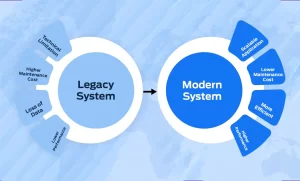
Owning a vintage car is considered a luxury but having business software that is that old, not so much. After all, a vintage car takes a lot of time and money to upkeep and it is not for a regular everyday drive is it? Yet, the software that a company runs on is often the central lifeline that connects its various departments and processes. If the software is up-to-date, your teams are working at their fullest capacity, departments are collaborating effortlessly and customers face no time lags. If the software is ineffective, however, each of these operations take longer than expected time to accomplish and this means cost of operations swirls skywards.
What is a Legacy System?
A legacy system refers to outdated business software or technology that has become inefficient or incompatible with modern applications. Though still operational, these systems often slow down operations and increase maintenance costs. Legacy systems are harder to integrate, more prone to security risks, and can hinder your company’s growth.
Legacy systems can be holding your company back and causing it to lose its competitive edge. There are two ways to resolve this: either switch out the system completely or modify aspects of the existing software to modernize it. The latter approach, also known as code refactoring or software modernization, can prove to be quicker and more cost-effective for companies.
5 Signs It’s Time for Legacy Software Modernization
So how do you know when software modernization is in the cards? Here are 5 signs your legacy software is hindering business growth.
1. Your system is slow and prone to crashes
Are your processing systems working slower than usual? It might be time for a software upgrade. As software ages, parent companies tend to roll out fewer updates and new features, because they can significantly slow down the system. This is problematic for a number of reasons. Slow systems can have a domino effect within your organization. It can lead to a drop in employee productivity, which can impact the quality of your customer experience.
Even more critically, outdated software can often crash without warning, which could lead to a loss of critical data. Code refactoring or upgrading the legacy software can protect your data, prevent hanging and ensure the IT backbone of your company is running seamlessly.
2. The platform is difficult to maintain
Any type of software needs to undergo routine maintenance but the cost of maintenance does not have to eat into a large chunk of your budget. Companies often delay modernize legacy systems because of the anticipated costs, but the cost of maintaining outdated software could actually prove to be far more expensive in the long term.
When software becomes obsolete, it can be very difficult and expensive to find and recruit people who are still skilled in that software. Additionally, you might find it harder to source hardware components as the company might have slowed down or stopped production of them. Software modernization can help you swap your legacy system for the latest upgrades that are far easier to maintain.
Most cloud technology vendors include the cost of maintenance within their pricing plans, which means that you do not need a full-time in-house maintenance team to ensure that the software is working smoothly.
3. The software is not compatible with other applications
Any organization uses a gamut of applications and tools to carry out day-to-day tasks. These could range from internal collaboration and communication tools to customer-facing applications like chat support and central help desk software. The efficacy of these tools lies in the degree to which they are all integrated with each other. This allows various departments and functions to work together cohesively, which in turn improves productivity.
Legacy software, however, might not always be compatible with new applications. Because of this, your company could be missing out on critical new features available in the market., especially those that use AI automation technologies. This could especially hurt your competitive standing if rival companies have moved on to newer technologies and are able to make full use of the latest applications.
Switching out your legacy systems for a new upgraded version can help you deliver the best experience to your employees and customers. A modern ERP software, for instance, can connect with internal communication tools and ticketing systems between various departments and improve cross-team collaboration. This can help customers get faster and more accurate solutions to their issues.
4. There are security lapses and vulnerabilities
Quite possibly the biggest repercussion of using outdated legacy systems is that it can leave your organization wide open to the threat of cyberattacks. For instance, The Royal Bank Of Scotland (RBS) had IBM mainframe systems using an obsolete language COBOL that were built before the mobile banking age. This meant it faced numerous IT glitches such as blocked user accounts and payment processing issues. It escalated to an estimated $245 million loss in a 2012 update that crashed systems.
If sensitive data is leaked or compromised in any way, then companies will often have to pay hefty fines to regulatory bodies. It can also severely affect the image of the company and lead to a loss of trust from customers and investors.
Software needs to be routinely audited to proactively identify vulnerabilities and resolve them, but there’s only so much that maintenance can do. As cyberattacks get more sophisticated, your software needs to be upgraded to meet the challenge. Code refactoring can alter the core software, making it more modern and secure.
5. The system is very hardware-dependent
A few businesses still have on-premise systems and these are typically very hardware-dependent. Because of this, they are expensive to maintain and difficult to scale up. But the biggest drawback of using on-premise software is that they often require employees to work on-premise as well. Clearly, in the post-pandemic world, this is not always possible.
Modern cloud-based software uses little to no hardware and allows you to build a remote, flexible workforce. Depending on the extent to which your legacy software is embedded with other platforms within the organization, an extensive internal applications modernization exercise will need to be carried out to ensure your systems are cloud-ready. This will ensure that your new software isn’t just cloud-based, but also works smoothly with your existing technological infrastructure.
Conclusion: Future-Proof Your Business
All technology ages at some point. Companies need to be mindful of this fact and keep assessing their software to identify when it’s time for an upgrade. Applications modernization can help improve the efficiency of your technological infrastructure. It fuels business growth, helps your employees work better and empowers them to deliver the best service to your end-customers.
iTech India’s global services applies a proven legacy system assessment framework to our client’s existing solutions to provide an assessment on architecture, code quality and scope for growth of existing business solutions. Based on the report we provide different approaches to custom your legacy modernization. Talk to us today.








